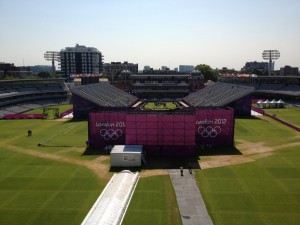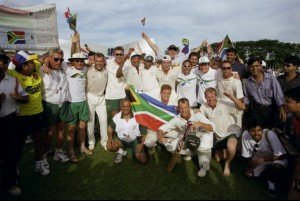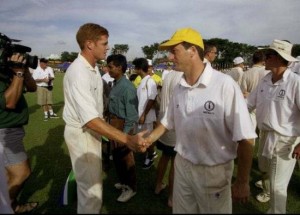
A gradual but inevitable descent into cricket-based loathing and bile.
Classic Series Review: Kuala Lumpur Commonwealth Games, 1998
We’re a pretty single-minded lot here at 51allout and it’s difficult for anything not exclusively cricket related (such as spouses, children and personal hygiene) to maintain our attention for long. So when we realised that our favourite sport wasn’t featuring at the glorified school athletics carnival about to take place in London Town, it was hard for us to take it seriously. However it seems quite a few people are taking this Olympics gig very seriously indeed. At the very least it seems set to attract more attention and spectators than this season’s Friends Life T20 tournament has managed. As a result, we got to thinking whether cricket had missed a trick by not featuring alongside badminton and Greco-Roman wrestling for the world’s attention over the next few weeks. And it’s for this reason that we decided to have a look back on the last time cricket strutted its stuff on the (relative) world stage, and incidentally the last time South Africa won anything of note, at the Kuala Lumpur Commonwealth Games, all the way back in 1998.
Whilst Malaysia might seem on odd location for cricket to make its debut at an international (or at least, international in terms of only those nations that actually matter) games, Kuala Lumpur wasn’t a completely new venue for cricket; it was already the host of the Super Max 8’s tournament. For those who don’t remember that particular version of hit and giggle cricket, Super 8’s was an early form of T20 cricket which consisted of eight players on each side, took place over 14 overs for each innings and featured special ‘Max Zones’ on the field where runs counted double. The format, unsurprisingly, failed to catch on, but all we know is that we want some of what Allan Border and Martin Crowe were on when they came up with the rules. The competition did leave Malaysia with a legacy of grounds that were fit for staging cricket however, and so it was that famous venues such as the Rubber Research Institute in Sungai Buloh and the Selangor Turf Club came to host international cricket matches. Although admittedly the competition was only accorded ‘List A’ status by the those renowned party-poopers at the ICC.
The ICC’s attitude probably played an influence in the response of nations such as India, Pakistan, and South Africa who all decided to send weakened teams to the tournament, whilst England didn’t bother turning up at all as they were far too busy formulating their master plan that would soon see them become the lowest ranked side in Test cricket. The Australians, sensing blood and an easy gold medal, sent a full strength squad to the tournament. The most interesting response came from the Caribbean however. Instead of playing under the usual West Indies flag, they sent three teams instead: Jamaica, Antigua and Barbuda, and Barbados. The likes of Canada, Northern Ireland and Kenya all came along to make up the numbers and the chance to be sledged by Steve Waugh.
The tournament took the form of four groups of four teams. Thankfully the short length of the Games meant the organisers couldn’t indulge in their penchant for typically over-bloated formats, and the knock-out stages consisted of the top teams from each group competing in a semi-final, and then the bronze medal play-off and final. The group stages were dominated by the Test playing nations, as to be expected, although Antigua and Barbuda gave India a scare, reducing them to 77/7 at one stage, before the Indians rallied and rain then washed out the rest of the match. The combination of inclement weather and new pitches which generated tennis ball bounce meant it was a tournament for the bowlers. Unsurprisingly it was the New Zealanders who seemed most at home, easily topping their group and in the process dispatching Pakistan. They lined up against Australia in the semi-finals, with South Africa playing Sri Lanka in the other. Pakistan and India, knocked out in the group stages, were probably just happy they didn’t have to pretend they cared any more.
The first semi-final saw South Africa bundle Sri Lanka out for 130. With the game, and a spot in the final, looking to be in the bag, South Africa responded with characteristic form and proceeded to start choking like an English footballer faced with a penalty shoot-out. The South African wickets tumbled, and at 96/9 all looked over. However, a tenacious last wicket stand between Nicky Boje and Alan Dawson saw the South Africans limp over the line. The other match was a more straight forward affair, as the Kiwis, likewise desperate to conform to expectations, were annihilated yet again at the semi-final stage of an international tournament. Put into bat New Zealand were rolled for 58, a total Australia took all of ten overs to pass, giving them the rest of the afternoon to catch up on learning the words to Advance Australia Fair for their inevitable gold medal presentation.
The final match (after the Kiwis had earlier won the bronze medal play-off) saw the Australians put into bat. They immediately began throwing their wickets away at a rapid rate and it was only a composed 90* from captain Steve Waugh that saw them reach 183 all out. Despite being a middling target, given their opponents reputation the Australians were still probably confident of winning. The eventual outcome of the match however leads us to suspect that the 19th September, 1998, must have witnessed a full lunar eclipse at some point. Clearly something supernatural was occurring that day, for it saw South Africa not choke in a major cricketing tournament. To be sure the South Africans tried their best to throw the game away, bleeding wickets regularly from 158/2, but someone or something was on their side and they eased home with four wickets to spare.
Considering that the Kuala Lumpur Games was the one and only occasion that cricket has featured on such a stage, it’s fair to say the tournament wasn’t considered a success. The ICC has subsequently consistently greeted any further suggestions of cricket at the Olympics or Commonwealth Games with a bored shrug, preferring to count their riches instead of upsetting the Future Tours programme. There were noises that the format would be revived for the 2010 Commonwealth Games in Dehli, but they were quickly silenced by the heavyweights in charge of the IPL. Likewise there has been talk that Glasgow, Commonwealth Games hosts in 2014, intend to include cricket but that would require both clear weather and the massive task of cleaning up all the broken glass and used syringes from the outfields first.

In their desperation to avoid a 3-nil whitewash, some enterprising English fans have taken ‘digging up the pitch’ to a whole new level.
It’s the Olympics though that remains the premier stage for the code to introduce itself to new audiences, and T20 cricket seems to be tailor made for the format. That cricket is not part of the London games is highly regrettable. Even the argument that the grounds are needed to host Olympic events, like archery at Lord’s, is surely a poor excuses for not pushing the concept harder. For the time being though it seems the 51allout team must make do trying to make sense of synchronised swimming, and wondering how good Chris Gayle would be at this table tennis lark.




1 Comment
Post a Comment
1
Matt H
27 Jul 2012 14:31
I look forward to someone contributing Classic Series: Cricket at the Olympic Games 1900.